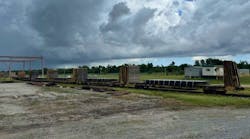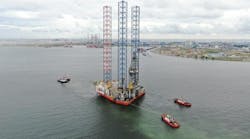Marshall DeLuca
International Editor
Watching for movement in oil demand
Most drilling contractors in the Gulf of Mexico see a poor 1999 headed in their direction and are taking steps to forestall serious utilization and cash flow problems. Operators in the US Gulf are predicted to continue to cut budgets through the first quarter. As a result, more rigs will be cold stacked. Contractors are trying their best to keep utilization up and day rates stable.
One of the most accurate measures of the rig market is Global Marine's monthly-published SCORE (Summary of Current Offshore Rig Economics) report. The SCORE compares current rig day rates to the profitability of rates at the peak of the last offshore drilling cycle (1980-81), when speculative new rig construction was common. An accompanying graph shows the SCORE for the Gulf of Mexico in terms of jackups and semisubmersibles from January 1996 to October 1998, and best exemplifies the difficulties being encountered by drilling contractors in US Gulf operations.
The SCORE for jackup drilling units in the Gulf of Mexico is now at the lowest level it has been in the past two years. The peak was hit in February of this year and has been on the decline ever since. Semisubmersibles drilling units are also feeling the utilization crunch. Semi levels have been declining, but not at the rate of the jackups. Semi utilization rates show improvement over two years ago.
Rig utilization, for the most part, remains stable. Utilization rates have remained at 75-80% for the past several months. But, with more operators cutting budgets, utilization is feeling the crunch. Reports indicate there are about 48-49 jackups available today, a number that contractors hope represents the bottom of the cycle.
Along with this has come the ever-increasing softness in day rates. Contractors are dealing with situations where drilling units come off contract at rates of $65,000 per day and face rates half of that for the next contract. By their nature, day rates tend to fall much faster than they rise.
1999 forecast
Contractors are not predicting any light at the end of the tunnel in the near future and are preparing themselves for a tough run in 1999. Bob Rose, President and CEO of Global Marine, said bluntly that the the Gulf of Mexico will be down in 1999. "Budgets are going to be down substantially from the current year and that will be reflected in rig utilization. There are roughly 48-49 jackups available today. I see that being, hopefully, the bottom. With any sort of improvement in gas deliverability and gas prices firming up, we may see a little bit of activity pick up here during the heating season. But, I expect in the spring of next year, if oil price forecastings are accurate at the low end, we will back down to this level of activity."He added, in regard to deepwater operations: "The deepwater unquestionably is going to be soft. The thing that insulates that deepwater market somewhat is the nature of the long-term contract, which most of the drillers have in the newbuild rigs and conversion rigs. That is not to say that deepwater at the lower end will not suffer. It already is suffering. Second generation shallow water rates are about 30% of what they once were, and that market will continue to be soft."
A representative of Santa Fe Drilling International concurs with the disappointing comments: "It doesn't look good. Our predictions do not look positive. One thing that is of interest, normally during the December period of time, is that we have a number of invitations to bid delivered to us. We have seen very, very little of that. Invitations to bid are almost non-existent at this period of time."
R&B Falcon Drilling (US) President Bernie Stewart also commented: "The thing about the drilling business is that we are in what we call a dry demand business. We are the second derivative away from energy - our demand completely ties back to the demand for oil and gas. When those things go away, our markets are terrible. Until there is some kind of positive change in the outlook for commodity price, then we are going to have to hunker down and weather the storm. That's our whole strategy."
Turnaround when?
So when will it get better? Rig contractors are asking, but there are few answers. According to the Sante Fa representative: "It's hard to say. Nobody can (predict) do that. It is totally out of our control. I think things will remain the same until the middle of next year, and at that time I don't know if it will get better or remain the same."Bob Rose offered his prediction: "In terms of the product price (oil price), we are at least 18 months away before we see improvement in oil prices. If it really is 18 months away from improvement in product price, Wall Street will anticipate this in the stock market firstly with a response in stock prices. Secondly, we will have improvement in product price and confidence in that improvement in product price, then you will begin seeing activity in the drilling sector."
However, Rose adds, it will be at least a year after that improvement in product price before day rates get back to the levels experienced in the last few years. "Unfortunately, from day one, when product price is up and oil companies start going back to work, the first thing that has to take place before day rates improve is that idle rigs have to go back to work.
"The second thing that has to occur, all of the rigs that are working have to build a little bit of backlog. So in the US Gulf, every time that a jackup program becomes available, every rig is not available to bid that program. Then you will start to see day rates improve.
"Day rates follow utilization. Unfortunately, they don't improve as fast as they deteriorate. We have had rigs that have come off contract making $65,000 per day, and the next day get $25,000 per day. Now, when that turns around, it will take four wells to get from $25,000 back up to $65,000. The most you can only move up is about $10,000 increments.
"So, when the market turns around, rigs go back to work, rates start moving, you are looking at a year from that time to get the type of earnings we had a year ago." he stated.
Bernie Stewart also commented on the issue: "There was some question a few months ago whether it was going to be a three-month problem, a nine-month problem, or an 18-month problem. We don't know how long the problem is going to be, but we know it isn't three to six months and we think it's probably not nine months. And, with that being the case, we are telling everybody, that whenever it became clear and evident that's where things are, we're going into the hunker down mode."
Weathering storm
Contractors are just trying to weather out the storm and try to minimize losses. They need to keep rigs working and utilization at high levels, but the question is at what price? There has been some concern that some contractors are taking exorbitantly low day rates in order to keep the rigs working. This is outstripping demand and could have a disastrous effect on the market.Bernie Stewart said further: "Some of the players (rig contractors) have forgone any pricing considerations. That's where I have a hard time understanding what their thinking is. On the one hand, we know utilization in a situation like this is the most desirable thing you can have, but continuing to cut prices to try to outstrip the market utilization, commits yourself to a potential slowdown - and there is no other way around it."
So what needs to be done? Stewart says that "we need to stop the bleeding." He made the analogy between the industry and a bleeding patient at the emergency room of a hospital.
"Cash is blood and you've got to minimize that cash loss. If you don't, you are testing how much blood you've got in your system. If you're bleeding bad enough, chances are you're not going to live. We need to be trying to reduce bleeding to the lowest level and sit and wait until the market changes direction. You can't set yourself into a positive market scenario when the market gets like it is. You can't cut enough cost to make up for a tremendous fall in revenue."
Stewart believes that the contractors need to collectively take action to stop the downward spiral. "The only thing that makes sense is that the different participants try to keep the market to the number of marketed rigs, where they somewhat match total demand. That will keep the effective utilization rate on your marketed rigs up. That's the only chance in the world you've got to minimize your net cash loss whenever the market gets like it is right now."
He adds, "I think that we are a little bit more sophisticated as drilling contractors now, there are fewer players, there is a little bit more of a tendency to say 'let's see what we can do to rationalize this.' If not we are at the complete absolute mercy of the market, and we are just sitting here waiting for commodity prices to change. But, for the meantime, we are like a piece of wood that's adrift in the current. We've got no control."
The future
Regardless of the price of oil and the depression in the market, the business of the contractors is going to change in the near future. Contractors are beginning to get a new client base as a result of these mega-mergers. With more mergers speculated for the future, this will continue to impact the drillers.Santa Fe attributes some of the downturn to the consolidation. "One reason (for the downturn) is consolidation in the industry, and two - that the price of oil is low. People are deferring commencement of their projects until they see a change, as long as they are not constrained by concession agreements that may tie them into a certain commencement date for operations."
Bob Rose said of the mergers: "One of the things that I don't know the answer to is how drilling contractors will be doing business with their customers in the future. The business is going to be different than what it is today. When you put these mega-companies together, it seems that the way they do business within our industry will change. We are still trying to figure how it will change."
No matter what business will be like, the contractors will spend the coming months trying to minimize cash loss and keep their drilling units utilized. However, the only way to minimize loss is for the oil and gas demand to meet the supply. That equates to creating equilibrium between marketed rigs and demand. So, perhaps in the near future. there will be more agreement between the rig contractors as to what measures to take to stabilize the market, as Stewart suggests. Until that time, Gulf of Mexico contractors are gearing up for around 18 months of tough times.
Copyright 1999 Oil & Gas Journal. All Rights Reserved.




